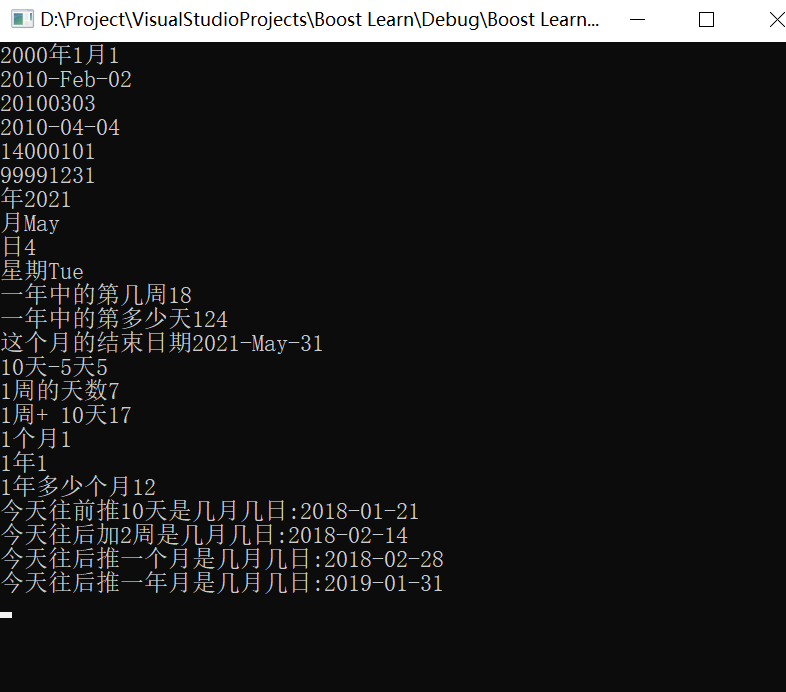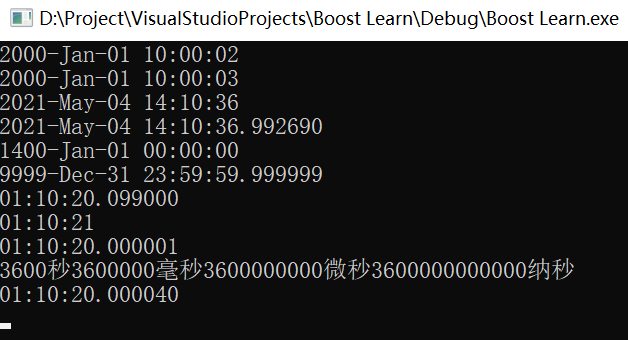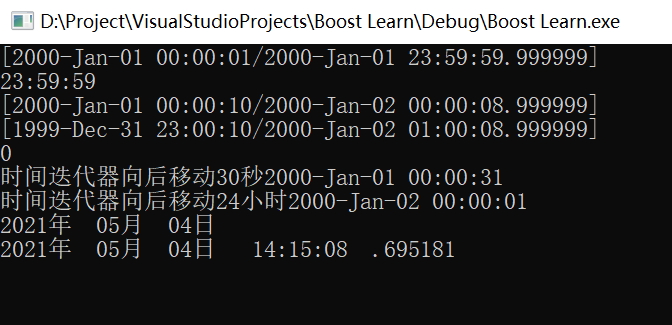C++ Boost库:简介和第一个示例程序
C++ Boost库:数值转换 lexical_cast
C++ Boost库:字符串格式化 format
C++ Boost库:字符串string_algo
C++ Boost库:字符串算法string_algo
C++ Boost库:类型推导BOOST_AUTO/BOOST_TYPEOF
C++ Boost库:分词处理库 tokenizer
C++ Boost库:windows下编译Boost库
C++ Boost库:日期时间库 date_time
C++ Boost库:智能指针scoped_ptr
C++ Boost库:数组智能指针 scoped_array
C++ Boost库:共享所有权的智能指针 shared_ptr
C++ Boost库:工厂函数 make_shared
C++ Boost库:共享有权的数组智能指针shared_array
C++ Boost库:弱引用智能指针 weak_ptr
C++ Boost库:禁止拷贝 nocopyable
C++ Boost库:计时器 timer
C++ Boost库:普通数组array
C++ Boost库:散列容器 unordered_set、unordered_multiset
C++ Boost库:散列容器 unordered_map、unordered_multimap
C++ Boost库:双向映射容器 bimap
C++ Boost库:环形缓冲区 circular_buffer
C++ Boost库:动态多维数组 multi_array
C++ Boost库:使用property_tree解析XML和JSON
C++ Boost库:简化循环 BOOST_FOREACH
C++ Boost库:随机数库 Random
C++ Boost库:引用库 ref
C++ Boost库:绑定库 bind
C++ Boost库:线程库 thread 跨平台多线程
C++ Boost库:互斥量 mutex
1. 简介
date_time库提供了时间日期相关的计算、格式化、转换、输入输岀等功能,为C++的日期时间编程提供了极大便利。
头文件:
#include<boost/date_time/gregorian/gregorian.hpp>
名字空间:
using namespace boost::gregorian;
静态库:
#pragma comment(lib, "libboost_date_time-vc100-mt-gd-x32-1_67.lib")
date_duration类:
date_duration表示日期长度,是以天为单位的时长,值可以是任意的整数可正可负。date_time库为date_duration定义了一个常用的 typedef:days,此外还提供了 months、years、weeks等另外三个时长类;分别用来表示月,年和星期。
2. 基本使用
#include<iostream>
using namespace std;
#include<boost/date_time/gregorian/gregorian.hpp>
using namespace boost::gregorian;
#pragma comment(lib, "libboost_date_time-vc100-mt-gd-x32-1_67.lib")
int main()
{
//构造日期
date d1(2000, 1, 1);
date d2 = from_string("2010-02-02");
date d3 = from_string("2010/03/03");
date d4 = from_undelimited_string("20100404");//无界定的字符串
date d5(min_date_time);//特殊时间值1400-01-01
date d6(max_date_time);//特殊时间值9999-12-31
//输出日期
cout << d1.year() << "年" <<(int) d1.month() << "月" << d1.day() << endl;
cout << to_simple_string(d2) << endl;//2010-Feb-02
cout << to_iso_string(d3) << endl;//20100303
cout << to_iso_extended_string(d4) << endl;//2010-03-03
cout << to_iso_string(d5) << endl;
cout << to_iso_string(d6) << endl;
//获取今天的日期
date today = day_clock::local_day();
cout << "年"<< today.year() << endl;
cout << "月"<< today.month() << endl;
cout << "日"<< today.day() << endl;
cout <<"星期"<< today.day_of_week() << endl;
cout << "一年中的第几周" << today.week_number() << endl;
cout << "一年中的第多少天" << today.day_of_year() << endl;
cout << "这个月的结束日期" << today.end_of_month() << endl;
//时间长度(最小单位是 天)
days day1(10);
days day2(-5);
date_duration du1 = day1 + day2;
cout <<"10天-5天"<< du1.days() << endl;
weeks w1(1);
cout << "1周的天数" << w1.days() << endl;
date_duration du2 = w1 + day1;
cout << "1周+ 10天" << du2.days() << endl;
months mon1(1);//一个月无法知道是多少天 ,并且无法加天数
cout << "1个月" << mon1.number_of_months() << endl;
years year1(1);//一年无法知道是多少天,并且无法加天数
cout << "1年" << year1.number_of_years()<< endl;
//如何知道一年多少个月
months mon2= year1 + months(0);
cout << "1年多少个月" << mon2.number_of_months() << endl;
//日期+ 日期长度 = 新日期 ,很实用
date d10(2018, 1, 31);
cout << "今天往前推10天是几月几日:" ;
cout << to_iso_extended_string( d10 + days(-10) ) << endl;
cout << "今天往后加2周是几月几日:";
cout << to_iso_extended_string(d10 + weeks(2)) << endl;
cout << "今天往后推一个月是几月几日:";
cout << to_iso_extended_string(d10 + months(1)) << endl;
cout << "今天往后推一年月是几月几日:";
cout << to_iso_extended_string(d10 + years(1)) << endl;
getchar();
return 0;
}
执行效果:

3. date_period类
date_period类用来表示日期范围的概念,它是时间轴上一个左闭右开区间,端点是两个date对象。
日期迭代器:
日期迭代器可以用++、--操作符连续访问日期,这些迭代器包括:day_iterator、week_iterator、month_iterator和year_iterator注意:它们并不符合标准迭代器的定义,没有difference_type、pointer、reference等内部类型定义,不能使用std::advance()或者+=来前进或者后退。
示例代码:
#include<iostream>
using namespace std;
#include<boost/date_time/gregorian/gregorian.hpp>
using namespace boost::gregorian;
#pragma comment(lib, "libboost_date_time-vc100-mt-gd-x32-1_67.lib")
int main()
{
date d1(2000, 1, 1);
date d2(2000, 2, 1);
//构造一个日期范围
date_period dp1(d1, d2);//两个日期确定一个范围
cout << dp1 << endl;//左闭右开,不包含2000/2/1
cout << dp1.length() << endl;//返回这个范围的天数
//把日期范围平移
dp1.shift(date_duration(10));
cout << dp1 << endl;//向后移动10天
//把日期向两边延伸
dp1.expand(date_duration(1));//向两边移动一天
cout << dp1 << endl;
//检测某个日期是否在这个日期范围里面
cout << dp1.contains( date(2000,2,20) ) << endl;
//日期迭代器
date d3(2000, 1, 1);
day_iterator it1(d3,10);//默认步长是1
++it1;//不会影响原日期,只是输出结果
++it1;
cout <<"day_iterator "<< *it1 << endl;
week_iterator it2(d3, 2);
--it2;//向前移动2周
cout << "week_iterator " << *it2 << endl;
month_iterator it3(d3);
--it3;//向前移动1月
cout << "month_iterator " << *it3 << endl;
year_iterator it4(d3, 10);
++it4;//向后移动10年
cout << "month_iterator " << *it4 << endl;
return 0;
}
运行结果:

4. ptime类
date_time库它包含两个组件,处理日期的组件 gregorian和处理时间的组件 posix_time。date类用于创建日期,ptime类则用于定义一个时间。
ptime是 date_time库处理时间的核心类,它使用64位(微秒)或96位(纳秒)的整数在内部存储时间数据。
头文件:
#include<boost/date_time/posix_time/posix_time.hpp>
名字空间:
using namespace boost::posix_time;
示例代码:
#include<iostream>
using namespace std;
//日期组件
#include<boost/date_time/gregorian/gregorian.hpp>
using namespace boost::gregorian;
//时间组件
#include<boost/date_time/posix_time/posix_time.hpp>
using namespace boost::posix_time;
#pragma comment(lib, "libboost_date_time-vc100-mt-gd-x32-1_67.lib")
int main()
{
//时间的构造
ptime t1 = time_from_string("2000-01-01 10:00:02");
cout << t1 << endl;
ptime t2 = from_iso_string("20000101T100003");//用字母T分割日期时间
cout << t2 << endl;
ptime t3 = second_clock::local_time();//秒精度
cout << t3 << endl;
ptime t4 = microsec_clock::local_time();//微秒精度
cout << t4 << endl;
ptime t5 (min_date_time);//特殊值
cout << t5 << endl;
ptime t6(max_date_time);//特殊值
cout << t6 << endl;
//类似日期长度date_duration,也有时间长度
//1小时10分钟20秒99毫秒
time_duration td1(1, 10, 20, 99*1000); //最后一个参数的单位是微秒
cout << td1 << endl;
//1小时10分钟21秒 (自动往前进位)
time_duration td2(1, 10, 20,1000 * 1000); //最后一个参数的单位是微秒
cout << td2 << endl;
//1小时10分钟20秒 1微秒
time_duration td3= duration_from_string("1:10:20:000001"); //最后一个参数的单位是微秒
cout << td3 << endl;
//hours
hours h(1);
cout << h.total_seconds() << "秒" << h.total_milliseconds() << "毫秒"
<< h.total_microseconds() << "微秒" << h.total_nanoseconds() << "纳秒" << endl;
//利用时间长度构造
time_duration td4 = hours(1) + minutes(10) + seconds(20) +microsec(30)+ microseconds(10);
cout << td4 << endl;
return 0;
}
运行结果:

5. time_period类
类似日期区间类 date_period,time_period表示时间轴上一个左闭右开区间,端点是两个ptime对象。
日期迭代器:
类似日期迭代器,时间也有迭代器,但是只有一个time_iterator;可以用++、--操作符连续访问时间。
示例代码:
#include<iostream>
using namespace std;
//日期组件
#include<boost/date_time/gregorian/gregorian.hpp>
using namespace boost::gregorian;
//时间组件
#include<boost/date_time/posix_time/posix_time.hpp>
using namespace boost::posix_time;
#pragma comment(lib, "libboost_date_time-vc100-mt-gd-x32-1_67.lib")
int main()
{
//起始时间
ptime p1 = time_from_string("2000-01-01 00:00:01");
//结束时间
ptime p2(date(2000, 1, 2));// 默认是 2000-01-01 23:59:59.999;
//产生一个时间范围, 类似 日期范围 date_period的用法
time_period tp(p1, p2);// p2>p1才可以
cout << tp << endl;
time_duration td = tp.length();//返回时间长度
cout << td<< endl;
//把时间范围向后平移9秒
tp.shift(seconds(9));
cout << tp << endl;
//把时间范围向两边扩大1小时
tp.expand(hours(1));
cout << tp << endl;
//某个时间是否在这个时间范围内
ptime p3 = time_from_string("2010-01-01 00:00:01");
cout << tp.contains(p3) << endl;
//----------------------------------------------------------
//类似日期迭代器year_iterator, month_iterator等,时间迭代器time_iterator
ptime p4 = time_from_string("2000-01-01 00:00:01");
time_iterator it(p4, seconds(10));//以10秒为步长
for (int i = 0; i < 3; ++i) ++it; //迭代器的移动不会影响p4的值
cout <<"时间迭代器向后移动30秒" <<*it << endl;
time_iterator it2(p4, hours(24));//以24小时为步长
++it2;//迭代器的移动不会影响p4的值
cout << "时间迭代器向后移动24小时" << *it2 << endl;
//日期时间格式化
date d1 = day_clock::local_day();
date_facet *pDF = new date_facet("%Y年 %m月 %d日");
cout.imbue(locale(cout.getloc(), pDF));//指定输出流的语言环境
cout << d1 << endl;
ptime t1 = microsec_clock::local_time();
time_facet *pTF = new time_facet("%Y年 %m月 %d日 %H:%M:%S %F");
cout.imbue(locale(cout.getloc(), pTF));//指定输出流的语言环境
cout << t1 << endl;
getchar();
return 0;
}
云型结果:























 2299
2299











 被折叠的 条评论
为什么被折叠?
被折叠的 条评论
为什么被折叠?










